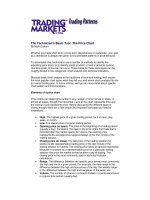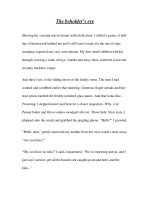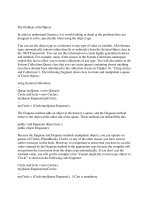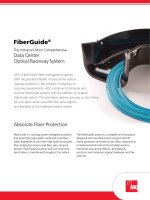Tài liệu The mare’s nest docx
Bạn đang xem bản rút gọn của tài liệu. Xem và tải ngay bản đầy đủ của tài liệu tại đây (8.67 MB, 378 trang )
THE MARE’S NEST
The War against Hitler’s
Secret Vengeance Weapons
“David Irving is the forensic pathologist of modern military history.
He dissects, analyses and describes with an unflinching, unsqueamish
surgical skill. His knife exposes the tumours, the cancers and horrors
of war. The reader becomes a spectator in an operating theatre. Coolly
detached himself, Mr. Irving spares him nothing.”
The Economist
This edition ISBN ‒‒‒
The editor of this work was Francis de Salis, who had
previously edited Leon Uris’s novel Exodus
David Irving’s The Mare’s Nest was first published in 64 by William Kimber Ltd,
in London, and by Little, Brown Inc in Boston. In Italy it was published by Arnoldo
Mondadori Editore, Milan; in Spain it appeared as Las Armas Secretas (Editorial
Planeta, Barcerlona). In Germany it was a major bestseller, published in 64 as Die
Geheimwaffen des III. Reichs by Sigbert Mohn Verlag of the Bertelsmann Group,
and serialized in Der Spiegel. Subsequent German-language editions included a
paperback published by Wilhelm Heyne Verlag of Munich and a book club edtion
by Weltbild Verlag, of Augsburg. This revised edition of The Mare’s Nest is slightly
abridged, but includes a hitherto unpublished chapter as a Prologue.
First published November 64
Revised edition published by Panther Books
Electronic Edition
Focal Point Classic Edition
© Parforce UK Ltd. –
An Adobe pdf (Portable Document Format) edition of this book is uploaded onto
the FPP website at as a tool for students and academics.
It may be downloaded for reading and study purposes only, and is not to be com-
mercially distributed in any form.
All rights reserved. No part of this publication may be commercially reproduced,
copied, or transmitted save with written permission of the author in accordance
with the provisions of the Copyright Act 6 (as amended). Any person who does
any unauthorised act in relation to this publication may be liable to criminal pros-
ecution and to civil claims for damages.
Readers are invited to submit any typographical errors to David Irving by mail at
the address below, or via email at Informed comments and correc-
tions on historical points are also welcomed.
Focal Point Publications
Windsor sl4 6qs
David Irving
he Mare’s Nes
The War Against Hitler’s Secret
‘Vengeance’ Weapons
“Lord Cherwell still felt that at the end of the
war when we knew the full story, we should
find that the rocket was a mare’s nest.”
Defence Committee (Operations)
October 43
What the Press said about this book
In the destruction of dresden, Mr. David Irving has already given us
one of the best and most illuminating books that have come out of the last
war. One is tempted to say that The Mare’s Nest is an even better one.
It is, first of all, an admirably clear and thorough account of the develop-
ment, production and operational deployment of the secret weapons with
which, as the twelfth hour approached, Germany still hoped to avenge her-
self on Britain and even to win the war. It is also an account of the measures
by which Britain tried to penetrate the mystery of the V-weapons and to
counter the potential threat which they created; this seems to me one of the
best descriptions I have ever read of how intelligence operations are actu-
ally conducted and their results assessed. Lastly, the book gives us a slightly
nightmarish illustration of how, in war, decisions of critical importance
may be determined by factors, of ignorance, human fallibility, prejudice,
egotism, which are hardly amenable to rational control.
— The Spectator (London)
Mr Irving’s book about the German V-weapons is remarkable because it
describes in parallel how the fight proceeded not only on the British side,
in the great argument about whether and what new German weapons were
likely, but also among the Germans, in deciding to what weapons, new or
old, resources ought to be applied at the war s climax.
Inevitably, in Britain, a key actor is again Lord Cherwell: disdainful as
ever of the views of lay and unscientific persons such as Mr Sandys, who
was given the task in the spring of sifting the evidence for German rockets,
dogmatic and obdurate as ever in sticking to his first view that these long
range rockets were so unfeasible scientifically as to be, in his scornful words,
a “mare’s nest” ; indignant and depressed when in the summer of 44 his
sceptical views were, fortunately, overridden, not just by the laymen but by
the scientists as well, when the decision was made that there was a threat to
be met by massive old-style bombing.
— The Economist
One of the most fascinating books I have read for a long time . . . I
wonder how many more skeletons are mouldering in Whitehall cupboards.
— Cassandra [William Connor] in The Daily Mirror
David Irving gives an authoritative account of the V-weapon offensive as
seen from Germany and from Britain. It presents the results of meticulous
research in both countries and is full of interesting quotations from official
British and German documents.
These have been successfully woven together into a coherent narra-
tive, written in a brisk style The account of how we progressively pieced
together the technical details of the V- rocket is an absorbing story of
scientific detection. . . Students will find in The Mare’s Nest a mine of impor-
tant information, while much wider circles will enjoy David Irving’s vivid
presentation of a strange story.
— Duncan Sandys in The Evening Standard (London)
The story of Hitler’s, secret weapons contains a rich catalogue of human
folly, and David Irving’s excellent book can be read with profit by statesmen
on both sides of the Iron Curtain.
Mr Irving produces some startling figures . . . The flying-bomb, at £
each, was a cheap killer. By contrast, the V- cost £, each to deliver a
similar payload. . . Indeed, it might be argued that the V- did more harm to
the German war effort than the entire Allied strategic bombing offensive.
How, Mr Irving asks, could a perceptive military economist like Albert
Speer, the German Minister of Supply, allow such a thing to happen?
— Paul Johnson in The New Statesman (London)
This is a factual account, based upon original documents and a great deal
of fresh information . . . but for sheer drama it has never been surpassed by
the most sensational “thriller.” . . . In these circumstances it is not difficult
to understand why, when Mr. Irving’s book is once taken up, it is not easily
put down.
— Sir Charles Petries in The Illustrated London News, December 6, 64
. . . and more at fpp.co.uk/reviews
The author of this work was given access to official documents; he alone
is responsible for the statements made, for the conclusions drawn and for
the views expressed in this work. In accordance with established practice in
these circumstances he was not permitted to identify official documents of
which he made use.
David Irving is the son of a Royal Navy commander.
After visiting Imperial College of Science & Technology and University
College London, he spent a year in Germany working in a steel mill and
perfecting his fluency in the German language.
Among his thirty-odd books, the best-known include Hitler’s War;
Churchill’s War, vol. i: “Struggle for Power,” vol. ii: “Triumph in Adver
-
sity”, and vol. iii: “The Sundered Dream”; Accident, the Death of General
Sikorski; The Destruction of Dresden; The Mare’s Nest; The German
Atomic Bomb; The Destruction of Convoy PQ17; The Rise and Fall of the
Luftwaffe; Göring: a Biography, and Nuremberg, the Last Battle.
He has also translated several works by other authors including Field-
Marshal Wilhelm Keitel, Reinhard Gehlen, and Niki Lauda. He lives in
Windsor, England, and has raised five daughters.
Photo: Adolf Hitler’s generals visit Wernher von Braun’s secret missile
establishment at Peenemünde in March 1941
F
FOCAL POINT
The War Against Hitler’s Secret
Vengeance Weapons
David Irving
he
Mare’s
Nes
Books by David Irving
Und Deutschlands Städte Starben Nicht (with Günter Karweina)
The Destruction of Dresden
The Mare’s Nest
The Destruction of Convoy PQ.
The Memoirs of Field Marshal Keitel (translator)
Accident. The Death of General Sikorski
The Virus House
Formula : The Art & Science of Grand Prix Driving, by Niki Lauda (translator)
Breach of Security (with Prof. D C Watt)
The Service. The Memoirs of General Reinhard Gehlen (translator and editor)
The Rise and Fall of the Luftwaffe
Hitler und seine Feldherren
Hitler’s War
The Trail of the Fox
The War Path
Der Nürnberger Prozess
Mord aus Staatsräson
Wie Krank War Hitler Wirklich?
Uprising! One Nation’s Nightmare: Hungary 6
The War between the Generals
Von Guernica bis Vietnam
The Secret Diaries of Hitler’s Doctor
Adolf Hitler: The Medical Diaries
Der Morgenthau-Plan 44/4 (documentation)
Churchill’s War vol. i: The Struggle for Power
Göring. A Biography
Hess: The Missing Years
Führer und Reichskanzler
Das Reich hört mit
Deutschlands Ostgrenze
Hitler’s War & The War Path (updated, one-volume edition)
Die Nacht, in der die Dämme Brachen
Der unbekannte Dr. Goebbels (1938 diary ed. and transcribed)
Apocalypse 4. The Destruction of Dresden
Goebbels. Mastermind of the Third Reich
Nuremberg, the Last Battle
Churchill’s War, vol. ii: Triumph in Adversity
Banged Up: Survival as a Political Prisoner in st Century Europe
in preparation:
Churchill’s War, vol. iii: The Sundered Dream
Heinrich Himmler
Contents
Acknowledgements 3
Prologue
Introduction
Programmes of Revenge
The Intelligence Attack 4
Operation Hydra
The Bodyline Investigation 3
The Rocket in Eclipse 3
Retribution 33
The A4 Ascendant 6
Account Due 3
appendix i: Evidence on the Comparative
Costs of Rockets and Flying Bombs 3
appendix ii: The author recalls something
of the history of this book 3
Index 33
Acknowledgements
No book of this nature would be possible without the unselfish co-
operation of several hundreds of people who, having participated in
the events portrayed, are able to assist in establishing the circumstances,
successes and failures of the Allied Intelligence attack on German secret
weapons in the Second World War. It is not possible to give all their
names: many have asked that their names should not be recorded in
these pages, and others I am not at liberty to identify – the brave army
of Allied agents who channelled back to London the raw material upon
which that Intelligence attack was based.
My greatest thanks are due to Sir Donald MacDougall for allowing
me access to certain records of which he is the trustee, namely the pa-
pers of Lord Cherwell, and to Professor R. V. Jones for adding a large
part of the unknown details of this story.
Sir Alwyn Crow, Sir William Cook, the Earl of Birkenhead, Marshal
of the RAF Sir Arthur Harris, Air Marshal Sir Robert Saundby, Sir Frank
Whittle, Air Commodore J. S. Searby, DSO, DFC, Colonel T. R. B.
Sanders, Dr. Barnes Wallis, Mr. G. J. Gollin, Brigadier Charles Lin-
demann, Mrs. I. H. Lubbock, Mr. Jules Lubbock, Mr. P. A. Coldham,
Squadron Leader E. J. A. Kenny, Mr. W. R. Merton, Mr. T. A. Stewart,
and many others have provided me with material and personal records
upon which much of the British side of the story has been based.
I wish to express particular thanks to Dr. Albert F. Simpson, Chief
of the US Air Force Historical Division, through whose kindness a
volume of interrogation reports of former Peenemünde scientists
was made available to me. A further great volume of material was
provided for me by the National Archives in Washington.
the library of the Deutsches Museum in Munich, and its director,
Professor Klemm, generously provided me with copies of documents
held by them, and permitted me to study their unparalleled collection
of Peenemünde documents; I wish to record my gratitude to Dipl
Ing. Ernst Klee, curator of the Peenemünde archives at the Deutsches
Museum in Munich.
I am indebted to Dr. Wernher von Braun, to Colonel Leo Zanssen,
former military commandant of the Peenemünde establishment,
and to: Herr Walter Barte; the Landesarchiv Berlin; Herr Eckart von
Bonin; Dr. Kurt Diebner; Herr Horst Diener; Herr Fritz Hahn;
Professor Walter Hubatsch; Professor Friedrich Kirschstein; Dr. J.
Krinner; General Emil Leeb; Herr Hans Meissner; Herr F K. Müller;
Dipl Ing. Walter Riedel; Herr Hans Ring; Dorette Kersten and her
husband Herr Rudolph Schlidt; Herr Peter Spoden; Dipl Ing. Det-
mar Stahlknecht; Colonel Max Wachtel; Herr Wilhelm Henseler;
Colonel Hajo Herrmann; General Josef Kammhuber; the Deutsches
Wetterdienst; General Paul Deichmann; and the staff of the West
German Staff College, Hamburg-Blankenese, for the assistance that
all have rendered.
I wish to thank Messrs. Collins (London) for permission to repro-
duce the brief quotations I have used from Sir Arthur Bryant’s Triumph
in the West (). I also acknowledge the permission of the Controller
of HM Stationery Office to quote from publications and all official
records in which the Copyright is vested in the Crown.
’
Prologue: The Enigma
Like all manuscripts based in part on official files, this book was submitted
by the author, then aged , to the government for clearance. In July
the GCHQ security officer wrote to him: “The new chapter beginning,
‘Just as the analysis of inconsistencies . . .’ must not appear in any shape
or form.” With the official revelation of The Ultra Secret and the Enigma
story in this prohibition no longer applies.
J
ust as the analysis of inconsistencies has led to the most
unexpected discoveries in the field of applied science, so the
examination of apparently inexplicable contradictions in terms
can illuminate history’s more jealously guarded secrets.
The genesis of this particular story was a process developed and
applied by a consortium of Intelligence officers in an establishment
forty-seven miles from London, a process of such secrecy that neither
Cabinet Ministers nor Commanders-in-Chief nor even our most gal-
lant Allies could be entrusted with the burden of its knowledge.
Three inconsistencies will be found to occur in the story which
follows, of which only one is significant; these are the documentary
clues which we can best label “the petrol form,” “the radar plots,” and
“the bills of lading.” The three clues are to play significant parts in
this narrative as they, respectively, established that Peenemünde was
’
genuine and the second most important research station; identified
certain structures in France as flying-bomb catapults; and established
the probable existence of , German rockets.
Of the three, the alleged existence of the “bills of lading” is the
most questionable. Ostensibly, the bills were thrown up like chaff as
the grinding mechanism of an efficient network of SIS agents meshed
momentarily with the machinery of Germany’s secret weapon develop-
ment programme. In fact, their provenance was rather different.
On November , , after Peenemünde had been devastated by
RAF Bomber Command, firing trials of the A long-range rocket, op-
erationally to be termed V-, were resumed at the SS training ground at
Blizna in Poland. Intelligence learned of this in London. In a report to
the Cabinet in mid-July , a senior Air Intelligence officer claimed
that from captured “bills of lading,” referring to the traffic between
Peenemünde and Blizna, serial numbers of certain objects, shown by
photo-reconnaissance of Blizna to be rockets, had been extracted. The
serial numbers ranged in part from , to well over ,.
This evoked consternation in the Cabinet, as will be seen in a later
chapter. But what is even more revealing is an analysis of their prov-
enance. The Intelligence officer suggested to the Cabinet that the “bills
of lading” had been secured by an SIS agent operating in Poland. This
is impossible: on January , , the chief of Major-General Walter
Dornberger’s rocket transport staff had directed that “in virtue of a
special dispensation from the Reich Transport Ministry, no convey-
ance papers, either military tickets or bills of lading, are to be filled
out for A traffic.”
This regulation came into force on February , five days before the
trainload of ten A rockets, of which number , was one, emerged
from the exit-tunnel of the Nordhausen factory, and several weeks
before it was fired at Blizna.*
The “bills of lading” do not therefore exist.
* Rocket No. ,, for example, was launched from Peenemünde on April ,
.
So what was the Intelligence officer’s true source? Long before the
onset of the war, Intelligence had made strenuous efforts to break
into the German ciphers intercepted by the United Kingdom’s radio
monitoring organisation. No one underestimated the gains which
would derive from successfully cracking the high level ciphers used by
the German High Command, while at no time permitting the enemy
to become aware of this. “Correct information about the enemy does
not by itself win wars,” one Intelligence officer observed. “But it can
stave off defeat a very long time, and allow one to strike just when and
where it hurts most.”
The Germans had by that time developed one particularly reliable
machine cipher named Enigma. A senior civil servant, Joshua Coo-
per, conceived that if the German codes were machine-made, then a
machine ought to be able to comprehend them. (In , Cooper had
been transferred to the Air Ministry for Intelligence duties, while still
attached to the Foreign Office.)
His idea bore fruit. Post Office engineers were invested with the task,
and were so successful that their device was able to tackle a far wider
range of ciphers than that for which it had originally been planned.
This was installed at a certain Joint Services establishment in Buck-
inghamshire, to which a considerable staff of translators, interpreters
and evaluators was attached. “From then onwards, we could decipher
anything we got hold of,” said one; to add insult to injury, the British
device was considerably faster than that developed by the Germans
for the same purpose, with the result that British Intelligence often
had the clear text before its intended recipients.
This decoding machine remained Britain’s sole prerogative until its
functions were divulged to the Americans; this has not, of course, pre-
vented the Americans from claiming that such machines originated in
the USA. Presumably H. M. Government had been reluctant to correct
this view, because of the pain which would be caused by an admission
that such a device was in our possession during the war. The next of
kin of those lost in the disasters of war would draw no comfort from
’
the knowledge that Intelligence had forewarning of many of them.
Very early on, it was decided that, as a matter of strictest policy,
the Cabinet could be given only such Intelligence as could credibly
have emanated from more conventional agencies. The network of
Ministers and others to whom the digests of Intelligence secured by
this establishment were circulated was severely restricted. Hence the
invention of documents stolen by SIS agents, like the “petrol form,”
the “radar plots,” and the “bills of lading.”
Where no such cover story could plausibly be invented, the inter-
cepts had to be religiously ignored. Convoys were smitten, disastrous
air attacks were borne, while Intelligence had to stand by passively in
agonised impotence.
To this establishment, run jointly by the Foreign Office and Ser-
vices, must go much of the credit which in this book will perforce be
attributed to the service Intelligence directorates at large.
GERMAN GUIDED MISSILES ESTABLISHMENT,
Peenemünde
Purpose of test stands: X — A launching trials; VII — A motor
controls and launching trials; I — A combustion chamber static
test rig; VIII — A combustion chamber trials with turbo-pumps; IX
— Wasserfall rocket test rig; III — horizontal combustion chamber
rig; V — A fuel delivery system trials; VI — A motors and control
testing; XI — test rig for mass-produced A’s.
’
Introduction
O
ne afternoon early in August , a lone Liberator
bomber of the United States Eighth Air Force rolled
cautiously down the long concrete runway of a bomber
airfield in England, and lumbered into the air. Just two men were man-
ning the B-’s controls, the pilot, Lieutenant Joseph Kennedy, and the
wireless operator. Behind them, every cubic inch of the aircraft was
packed with high explosive, over twenty-two thousand pounds of it.
The plane had been stripped of its armament, and it carried only
enough fuel for the outward flight, a flight that would take it across
the Channel to a lonely, windswept field in the Pas de Calais, only a
few miles beyond the French coast. In the heart of this region there
was a shallow hill, and excavated beneath this hill was a Nazi gun bat-
tery with barrels over four hundred feet long, aimed at the heart of
London a hundred miles away.
From this vast gun site, called “high-pressure pump” by Adolf Hitler,
the Nazis were planning to pour a hail of six hundred -foot shells on
the capital of the British Empire every hour; and still the gun battery
was in German hands.
Work on the site had been pressed forward on Hitler’s personal
insistence. An eighteen-foot slab of concrete on the crest of the hill
pierced by the fifty muzzle openings of the gun barrels was all that
there was to attack. So the American air force commander had evolved
his own secret weapon: a Liberator bomber, laden with TNT, and a
volunteer crew who would bail out shortly before the plane crossed
the enemy lines. The Liberator would then be homed on to the sinister
“high-pressure pump” site by radio control.
Soon after Kennedy’s Liberator had taken off, its master plane took
the air.
The second plane was still some miles behind the Liberator when
the heavy bomber suddenly blew up with two blinding flashes. The
two-man crew died instantaneously. Lieutenant Kennedy, brother of
the later President of the United States, joined the ranks of the ,
Allied airmen who sacrificed their lives in the fight against the Ger-
man secret “V-weapons.”
the battle had begun in August , when early one morning
Mr. Winston Churchill, then staying at the Citadel in Québec, was
awakened to take a telephone call from England. At the other end
of the line, he recognised the familiar educated drawl of his son-in-
law, Duncan Sandys. Sandys had been put in charge of the British
Intelligence investigation of German “secret weapon” rumours some
months before.
Sandys said simply, “Operation Hydra has been a success!”
As he spoke, he was at an RAF Bomber Command Pathfinder
station in Huntingdonshire, England. Hydra was one of the Second
World War’s most decisive air attacks: six hundred miles away across
the North Sea, the German guided missiles establishment at Peene-
münde, on which Hitler had lavished upwards of £,, since
, was burning fiercely, over seven hundred engineers, technicians,
scientists and slave labourers lay dead among its ruins, and the onset
of the German V-weapon offensive had been delayed just long enough
’
to prevent it from dislocating the combined Allied invasion of Nor-
mandy ten months later.
The Allies’ most fantastic military gamble had come off: some six
hundred aircraft of Bomber Command had executed a daring low-
level raid in full moonlight on a target even more distant than Berlin.
Three hundred British airmen had not returned. But as Professor
Wernher von Braun, Hitler’s chief rocket engineer, knew, the dispersal
of all Peenemünde research would have to be put in hand. The result-
ing dislocation ensured that the V-weapon assault on London would
have to be postponed.
Hitler had planned to saturate London with a hundred V- rockets
and eight hundred V- flying bombs a day: each rocket was fifty feet
long, weighed twelve tons, and carried a one-ton warhead; each of
the flying bombs – small pilotless jet-propelled aircraft – carried a
deadly warhead packing a punch as big as the “blockbusters” being
dropped each night on Berlin by the RAF. He had personally promised
his Cabinet: “The V-weapon attacks are to be synchronised with the
Allied invasion of France.”
If Eisenhower’s operation had even momentarily lost its footing,
the course of the war could have been turned permanently against the
West; Germany with her jet- and rocket-propelled fighters could have
regained partial air superiority in the West, could have reinforced her
defences, and completed her underground oil-refinery construction
programme.
The first of the V-weapons, the deadly Fieseler flying bomb,
was not rushed into action until D-Day plus seven. During the next
fourteen days nearly , of these “malignant robots” were launched
against the British capital. At every Cabinet meeting, the grim news
poured in of the mounting toll in human life. In London, ,
houses a day were being damaged by the attack, and one-sixth of the
city’s vitally important war production capacity was lost.
Worst of all was the effect on the morale of the Allied troops fighting
their way out of the Normandy beachhead. Each night they could
hear the thunderous roar of ram-jet motors as the missiles streaked
out across the Channel towards England; each night the millions of
people living in the weapons’ path, this author among them, held
their breath as the motors suddenly cut, and the pregnant silences
followed, to end with shattering roars as the missiles’ warheads blew
up in someone else’s street.
The flying bomb was only the first of Hitler’s secret weapons. Said
General Eisenhower afterwards: “If the Germans had succeeded in
perfecting and using these new weapons six months earlier than they
did, the invasion of Europe would have proved exceedingly difficult and
perhaps impossible . . .” This book is a tribute to the airmen, scientists,
technicians, and Intelligence officers who combined to defeat Hitler’s
secret weapons, and to make the Allied victory possible.
’
A LONG RANGE ROCKET
The world’s first practical liquid-fuelled rocket. The internal gas
rudders enabled it to make a slow standing start from a conical firing
table (right). All sizes are in millimetres.
Based on an original in the Peenemünde archives
part one
PROGRAMMES OF REVENGE
“There is an extreme danger that something vital will be missed. In view
of Hitler’s recent statement that German inventive genius had not been idle
in developing new weapons of offence against this country, we cannot afford
to relax our watch as we have been forced to do. Unless some [staff] relief
is forthcoming [we] cannot accept responsibility for the surprises which
are likely to be sprung upon us by the enemy. . . .”
— Dr. R. V. Jones, November 20, 1942.
P A R T O N E
Programmes of Revenge
(i)
P
robably unintentionally, Adolf Hitler himself stimulated
Britain’s first concentrated investigation of enemy secret
weapons, when at a rally in Danzig on September ,
he broadcast to the world, calling upon England to barter for peace
now that he and Stalin had jointly overwhelmed Poland in “eighteen
days.”
While Neville Chamberlain, British Prime Minister, failed to suc-
cumb to these blandishments, a seemingly explicit threat could not be
easily ignored. The Führer talked, according to the BBC’s first hurried
translation of his speech, of a weapon “which is not yet known, and
with which we ourselves cannot be attacked.” Mr. Chamberlain directed
British Intelligence to determine the nature of this weapon, and Dr.
R. V. Jones, who had been appointed Chief of Air Scientific Intelligence
but eight days before, was commissioned with the investigation. Jones,
a tall, solemn physicist who had served his “apprenticeship” under
the capable tutelage of Professor F. A. Lindemann at the Clarendon
Laboratory, was invited to sift the accumulated Intelligence records
and to draw up a report on his conclusions.
The very earliest agent’s report, dating back to June , had re-
corded the inauguration in Germany of a course in bacterial warfare;









